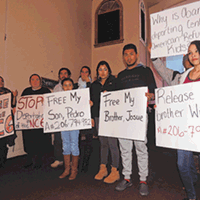(The following story is the result of a CL partnership with the Triangle-area INDY Week.)
"I'm a young person with a sort of old mind. Does that make sense in English?"
Pedro Salmeron says this in Spanish with an easy Salvadoran lilt, one that curls up at the ends of words into a quick tempo, like a song. But he articulates most with his eyes. They are dark and round, widening underneath thick, straight eyebrows that frame his face. Despite a 5-o'clock shadow emerging as a patch on his chin, the 20-year-old barely looks like an adult. But he speaks in a mature cadence, deliberate and sincere, with a deep, calm voice, like someone who has lived a thousand lives.
"We'd say you have an old soul," I tell him.
"Yes, exactly. And, I don't know, I feel like I'm a little boring," he laughs, explaining how he passes the time watching Charlie Chaplin films and reading Greco-Roman myths. We're having this conversation in September, outside of a supermarket in the province of San Miguel in El Salvador.
The sun begins to set. A couple of boisterous men walk through the sliding doors into the store. On their way in, their laughter grows louder, even mischievous. They're a few yards away from us. One of them stares.
Pedro looks over his shoulder at them. We're sitting at a table by the doors, next to an ice cream outpost. But he doesn't want to stick around for ice cream. The sky is getting darker.
"I should go home," he says.
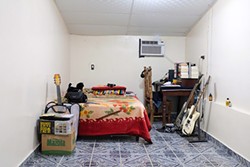
- Pedro's room.
Pedro has been back in El Salvador for a year, but he doesn't leave his house much. It's too risky. The dangers that prompted him to leave for the United States, eventually landing in Charlotte with his family at age 16, have only gotten worse. As he puts it, "The gangs are growing and cannot be tamed. They are completely out of control."
In November 2016, Pedro was deported from the Stewart Detention Center in Georgia, one of the harshest immigrant prisons in the country (three inmates have died there in less than a year, according to immigrant-rights advocates), where he'd been detained for nine months. Before that, he lived for nearly three years in Charlotte with his family — his parents (who arrived more than 10 years ago), his U.S.-born sister, and an uncle. When Pedro was detained, his case became part of the so-called NC6 — six Central American youths living in North Carolina who were rounded up by ICE in January 2016.
All of them said they had fled gang violence in their home countries. To date, two have been deported — including Pedro — both to El Salvador.
Since those arrests, gut-wrenching stories of youths detained and families broken apart have mobilized communities into action, documenting the men and women fighting to stay here. But what happens to those immigrants plucked from U.S. high schools and sent back to an increasingly dangerous Central America alone?
Pedro left behind a life he was just beginning to build, one hopeful with opportunity despite his undocumented status. His parents remain in Charlotte, in a house they bought with money earned in construction and housekeeping. But soon, they'll face a difficult decision. Next year, the Trump administration will end the temporary protected status program for Salvadorans that has kept Pedro's father in the country legally for a decade.
Pedro's parents will have to decide whether to stay here illegally for the sake of their 10-year-old daughter — a United States citizen — or pick up and leave for a native land now considered the murder capital of the world.
"The problem with being an immigrant is that you can't enjoy the same rights as everyone else," Pedro says. "And unjust things happen to you. But despite all that, so many people still live that way."
The Salmerons were never disillusioned by the promise of an American dream. They just want a future free from danger, free from fear.
currently, 700,000 Salvadorans live in the United States. They left what is considered the deadliest country in the world outside of a war zone. But it isn't just a recent surge of gang violence that has mangled a society of just over 6 million people. Blood and poverty, corruption and desperation are threads that link Salvadorans' stories through generations.
From 1980 to 1992, a civil war ravaged the small nation, claiming at least 75,000 lives. Amid increasing poverty, the leftist Farabundo Martí National Liberation Front fought the military-led government, which formed death squads in retaliation. By war's end, the United Nations Truth Commission found that more than 85 percent of the deaths, kidnappings and torture were attributed to the Salvadoran government, which was backed by the United States. In the early '80s, President Reagan directed billions of dollars to El Salvador to fight communism. By 1990, despite a U.N. agreement on human rights signed that July, the government's U.S.-trained paramilitaries, death squads and army units had only gotten more vicious, massacring entire communities and wreaking havoc on a struggling nation.
The war left behind a generation of trauma in a country that President Trump recently called a "shithole."

- Photos from Pedro's village in San Miguel, El Salvador.
Pedro's parents, Daniel and Carmen, who are in their 40s, remember the war well. Daniel says his brother was murdered by guerillas who assumed that his close-shaven hair meant he was working with the government. Ironically, perhaps, his brother had hoped his clean-cut look would help him stay alive, because the military targeted anyone it deemed delinquent in appearance as a member of the FMLN.
Daniel Salmeron was able to flee shortly after his son's birth through TPS, a visa program implemented in 1990 for migrants from countries that suffered long-term effects from natural disasters and violence. El Salvador was one of the first countries to receive TPS, due to its civil war and, later, earthquakes. TPS protects migrants from deportation and affords people like Daniel a work permit. But on January 8, the Trump administration announced the program would soon end for the estimated 262,000 Salvadoran TPS visa holders in the U.S.
It's common for Salvadoran parents who survived the war and are still struggling to survive its aftermath to leave. Many Central Americans migrate north ahead of their kids and determine what to do for their families once they arrive in the States. Daniel and Carmen left Pedro, then a toddler, with his grandparents and aunt, hoping to earn enough money in the United States and maybe come back to a better El Salvador.
"My father felt what it was like to be at war," Pedro says. "And from that war, the gangs were created. Our economy was so low that, instead of finding dignified work, because there wasn't any, it was easier for some people to just steal the very little that others had."
Today, much of El Salvador is controlled by these gangs, mainly Barrio 18 (or Calle 18) and Mara Salvatrucha (or MS-13), both of which have their roots in Los Angeles. In 2016, The The New York Times reported that gangs extort at least 70 percent of the country's businesses. Business owners could be killed on a whim if they didn't abide by the gangs' demands. The gangs also collude with the police and the government, which have turned a blind eye to much of the mayhem. The Wilson Center's policy forum estimates that 95 percent of the gang crimes reported in Central America go unpunished.
Before he left for the United States at 16, Pedro reported a gang threat. Young men who knew him from school, possibly recent gang recruits, approached him on the walk home one afternoon. "Join us or we will kill you," they told him — a chilling but common refrain among Central American migrants.
A few days earlier, Pedro's cousin's body had been found decapitated and castrated in a nearby town. The cousin, a carpenter, refused to give in to extortion. He was murdered at night, his body discarded in a cul-de-sac so that neighbors would find him in the morning.
"I had to leave immediately," Pedro says.
"He didn't even make it to his cousin's funeral," says Carmen.
She worried about him crossing the border alone at such a young age. It wasn't part of her plan. She and her husband wanted to bring their son in through a legal channel as a refugee. But after the cousin's murder, they knew it was time.
The drive from San Salvador to Pedro's village starts at 3:30 a.m. on a humid day in late September.
As the sun begins to rise, our truck jolts; the driver hit the brakes to avoid a cluster of rust-colored cows lazily crossing the highway. The road cuts through a jungle of banana trees that becomes a string of little towns bustling with morning foot traffic. Women carry baskets of masa on their heads, walking carefully through the streets and darting into storefronts, where they pound dough into pupusas.
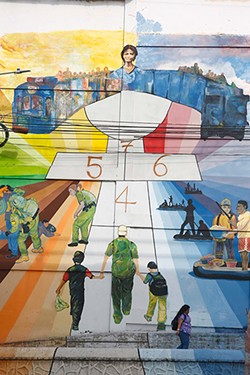
- Photos from Pedro's village in San Miguel, El Salvador.
As we drive into the villages, I notice something jarringly familiar: the mustard yellow and blood-red Wells Fargo logo jutting out of a worn building spruced up by fresh turquoise paint. The only modern sign among hand-painted calligraphy signals an ATM, where people can pull out their remittances from the U.S. in cash.
According to the International Organization of Migration, 17 to 18 percent of El Salvador's gross GDP comes from remittances. Of that, 30 percent comes from people holding TPS in the United States.
The further we drive, the more worried my driver becomes. He starts making calls to his family.
"My brother-in-law is from here," he says. "It's pretty bad."
I ask which gang was in charge. He says he's not sure, but in the last few months, youths have increasingly come under threat.
The highway crosses the Lempa River, one of Central America's largest rivers, which also serves as part of the border with Honduras. The border is a fount of trafficking, says Salvadoran journalist Lourdes Quintanilla. "Gangs, contraband," she explains. "The young population is especially vulnerable. There's nothing to do, no sports leagues, no community activities to center all the youths spread out in the villages."
She recalls a recent news story in which a schoolteacher tried to warn his students to stay out of trouble. Gangsters came into his classroom during the school day and murdered him in front of the class, just hours after killing his daughter.
Quintanilla says poverty perpetuates the cycle of violence. "It's super cliché, but the gang becomes a support system, especially financially, that we can't otherwise create within communities," she says. "And the same parents worried for their children are sending them to cross the border as a result."
We arrive at a town near Pedro's home during a holiday procession. Students dressed in military green and crisp hats practice an armed salute and hold rifles across their chests, while others form a drum line.
Cell phone service is shaky out in the country, so we inquire at the mayor's office of the family's whereabouts. A secretary recognizes Pedro's name; she flips through a large tome of handwritten birth records from the 1990s, finding him within a couple of minutes.
We are escorted into a small shopping center and up a narrow flight of stairs, where a woman selling pupusas from a takeout window becomes our accidental fixer. She insists on calling her nephew, who drives a mototaxi, to safely get us to Pedro's remote village. For a half hour we ride through foot traffic and a police caravan until the sound of cadets banging on the drum line become a faint thump in the distance. We putter through a forest of banana trees, its slick foliage darkening our rocky path.
We arrive at the Salmerons' home, which is high on a hill, and find the doors wide open, leading into a living room painted in sherbet hues of orange and pink. Pedro's childhood portraits are featured in giant-sized, lacquered prints that hang high, almost touching the ceiling.
Pedro's grandmother points to a neighbor's house a few yards away, just past the tall coconut trees that flank their hammocks. A couple of months earlier, she says, police raided it and arrested two young men — kids she's known their whole lives — for being involved in gangs.
Danger is ever-present here. A recent report by Amnesty International pegs the murder rate in El Salvador at 108 per 100,000 inhabitants; for comparison, the murder rate in the U.S. in 2016 was 5.3 per 100,000 inhabitants. The report says that "the spike in migration and asylum claims is directly connected to this violence."
It also lays out statistics from a survey of 747 Salvadoran adults who had migrated abroad and were then deported back. Forty-two percent said they were fleeing threats, crime, danger, and extortion; 23 percent said they were seeking a better economic status.
Those two factors — poverty and violence — are often connected.
In 2016, the World Bank reported that while "economic growth in El Salvador reached 2.4 percent," the country remained "the slowest growing economy of Central America."
"El Salvador is a country that offers absolutely nothing," says Pedro. "For someone who studies or was born in the United States, it would be difficult to live in a country like El Salvador. The economy is very low. It's very difficult to find an adequate job."
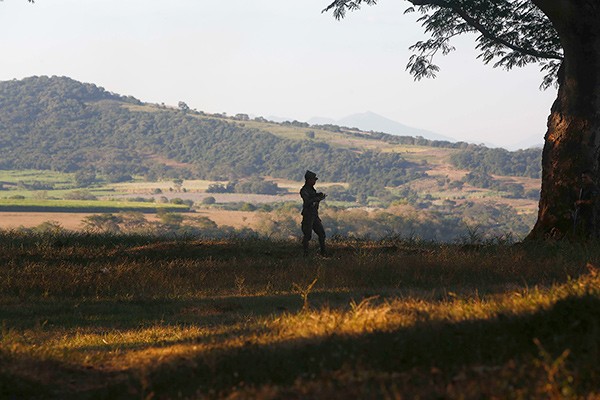
- Pedro lives in the rural countryside of El Salvador.
Compounding matters, because he turned 18 in the States, Pedro lacks proper identification in El Salvador, where people obtain a new ID card after becoming adults. That ID is needed to obtain a work permit. He is, in a sense, undocumented in his homeland, too.
Pedro fears going to school in El Salvador. He goes once a week to turn in homework, lamenting this is the third time he's repeated 10th grade. He worries about finding work.
El Salvador simply isn't equipped to manage the increasing number of deportees — or retornados — like Pedro, especially in rural areas. San Salvador is more blatantly sullied by gang violence, but community and professional organizations offer support and jobs for the deported, such as call-center gigs for English speakers.
But while Pedro risked the journey to the U.S. alone, his parents were on the other side, waiting for him. To move to San Salvador would mean he'd be completely on his own.
Many Salvadoran children are left fending for themselves while their parents migrate or work jobs away from home to barely make ends meet. And without parents or vocational options to climb out of poverty, some kids join gangs willfully.
"A young guy may say, 'I can get used to this and I'll be taken care of here," says Daniel. "And once they're in, they can't leave. If they do, they leave dead or end up in prison."
The Salmerons are subsistence farmers, living off the milk and cheese products their dairy cows produce. Pedro slipped back into his old lifestyle after returning to El Salvador, helping his family while he figured out how to get more viable work.
But about a month after he returned, Pedro says, he was taking the family cows out to a pasture about a kilometer from home. Four men wearing masks ran up to him. They said they knew him, though Pedro did not recognize their voices. They gave him an ultimatum, the same one that prompted him to flee in 2014: join us or else.
"They said they knew I was in America and assumed I had money," he recalls.
Pedro ran home as quickly as he could. He filed a police report, but he hasn't heard anything about his case since.
The arrests of the NC6 led to a public campaign that resulted in the eventual release of four of the young men. Among them was Wildin David Guillen Acosta, a Durham high school student whose case sparked national interest. With his deportation ordered and a team of lawyers and activists fighting to stop it, Acosta, now 21, lives in limbo in Durham.
According to the United Nations, an estimated 500,000 migrants cross Mexico's southern border each year. The majority comes from Central America's northern triangle: Guatemala, Honduras, and El Salvador. Each year, at least 20,000 of them vanish and presumably die on the journey to the United States.
In summer 2014, President Obama ordered an emergency response at the border for what was labeled an unaccompanied-minor crisis. The number of youths who entered the country had spiked from 16,000 in 2011 to more than 68,000 in 2014. Pedro was one of more than 1,000 so-called unaccompanied minors who settled in Charlotte in 2014, according to The Charlotte Observer.
When he crossed into Texas in the summer of 2014, Pedro was detained for about a month, a normal procedure for Customs and Border Patrol. During the 2014 fiscal year, the Border Patrol apprehended 68,541 unaccompanied children at the U.S.-Mexico border; many, like Pedro, were given a date to show up in court — though, despite looming deportation orders, ICE usually doesn't pursue unaccompanied minors until they turn 18.
As soon as they were notified of his detainment, Pedro's parents found a lawyer to begin seeking asylum. But they soon learned that migrants like Pedro don't have much of a chance in the American system. The criterion for asylum is to demonstrate a credible fear of persecution based on one's "race, religion, nationality, membership in a particular social group, or political opinion." Despite the harrowing statistics about violence in Central America's northern triangle, judges rarely factor gang carnage in their decisions.
"Pedro's claim was, 'I am scared to go back to El Salvador, I will get killed,'" says Bradley Banias, the last lawyer to represent Pedro. "The merits of an asylum based on persecution from a gang for a teenage male in El Salvador are very difficult if not impossible."
The current denial rate for Salvadorans seeking asylum in the U.S. is almost 83 percent, with Hondurans (about 80 percent) and Guatemalans (about 77 percent) not far behind.
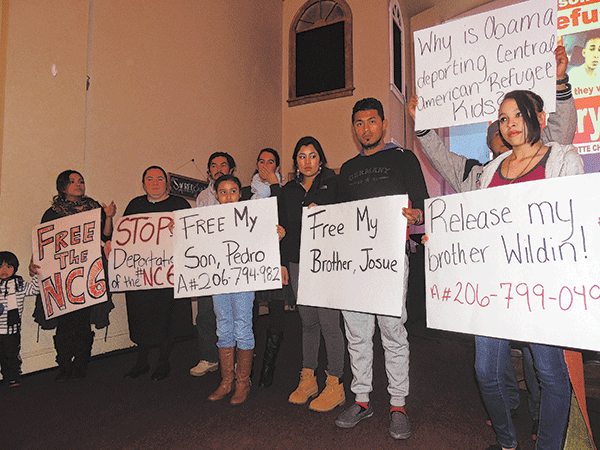
- Family and friends of the NC6 rally in support of them in February 2016. (Photo by Ryan Pitkin)
In January 2016, ICE's Operation Border Guardian targeted anyone who had entered the country illegally after January 2014 — the very same youths deemed a humanitarian crisis less than two years earlier. Once the minors turned 18, ICE was ordered to place them in adult detention centers, where they lost their unaccompanied-minor status.
According to ICE spokesman Bryan Cox, the agency does not collect data based on age, so there's no telling how many 18- to 20-year-olds were detained in 2016.
"A person may have come in as a juvenile," says Cox, "[but] as a legal adult that comes into ICE's custody, that's irrelevant."
As Operation Border Guardian was ramping up, Pedro was coming of age in Charlotte. Reunited with his parents and meeting his American-born sister for the first time, he felt a sense of relief he'd never had before. He joined his father, fellow Salvadorans, and new Mexican friends in playing music on the weekends. By the time he turned 18, Pedro knew how to play nine instruments.
By the end of 2015, rumors of ICE raids began circulating through the immigrant community. The Salmerons decided that school wasn't safe and pulled Pedro from his classes.
That didn't protect him. On January 26, 2016, ICE agents arrested Pedro. He was riding in a truck on the way to a construction job with his father and other workers.
The agents said they had a warrant for Pedro's arrest. The Salmerons had long feared this would happen; they say Pedro's first lawyer had accepted a voluntary departure during the asylum-application process, without advising the family beforehand. (The family hired a lawyer from the the law offices of Stefan Latorre, a firm based in Charlotte, and accuses the firm of malpractice. A lawyer from the firm said it does not comment on its cases.)
When officials pulled Pedro out of the car, Daniel says an ICE agent spoke to him in Spanish: "'Don't worry,' he told me. 'I'm a father, too, and I'll make sure he's fine.'"
Pedro remained quiet and polite, looking at his father as the officers yanked zip ties around his thin wrists.
"They were out hunting them," Carmen says. "They were being hunted."
The courts "referred to Pedro, a noncriminal, as a high-priority case," Banias says. "Basically, they were going to deport him no matter what."
Banias handled Pedro's last case, a plea to get him out of the detention center. He also worked for Bilmer Pujoy Juarez, another of the NC6 detained at Stewart. The boys' court hearings were scheduled back to back. Banias filed habeas petitions for each, trying to prove that they were held in detention for an unlawful and unconstitutional amount of time.
Banias argued Pedro could not be deported in the foreseeable future because of his pending asylum case, which would require him to stay in the country. But then, during a September 16 court hearing in Columbus, Georgia, the prosecutor revealed a key clerical error. Banias had in his possession the official asylum interview notice mailed to the Salmeron family to prove that Pedro's asylum claim was indeed still pending. But the prosecutor stated that the "computer system erred and sent out these notices."
This mistake discredited Banias's argument. Because asylum can only be granted to someone on U.S. soil, Banias thought that, with a pending application, he could get Pedro out of detention and at least buy him some time.
The public outcry for Pedro's release reached U.S. Representative Alma Adams, a Democrat whose district includes Charlotte. She wrote the director of ICE in March 2016 — the same month Creative Loafing originally wrote about Pedro's plight — on Pedro's behalf and followed up with a phone call that May. In August, she visited Pedro at Stewart and released the following statement: "As a mother and as a former educator, Pedro's case is personal for me. No young person should be ripped away from their family and their community and thrown into a broken immigration system."
Despite the Salmerons' appearances at rallies and on local television news, Pedro's case slipped from the public eye. As Mayra Arteaga of the Charlotte Legal Advocacy Center explains, "He had already dropped out of school, so he didn't fit into the student narrative. His story just didn't become popular enough."
Bilmer, who lives in Greenville, was freed. Pedro didn't have the same luck.
"We basically gave the government a hard enough time that they just gave in on that one," Banias says. "We got Bilmer out. They gave up on Bilmer and doubled down on Pedro."
While he was detained at Stewart, ICE agents dragged Pedro out of his cell on two separate occasions in the middle of the night and threw him into a van, leaving him to wait in the dark, thinking he was about to be deported, before returning him to his bunk an hour or so later.
Pedro assumes that the first time was meant to be a form of psychological manipulation; such reports out of Stewart are common, according to immigrant advocates. The second time, though, "the plane literally broke down. So they took the deportees back."
The third time wasn't a joke or a mistake. Pedro was deported on a commercial airline in November 2016. Two ICE agents bought him a plane ticket, escorted him to the gate, and waited until it was time to board. He flew unaccompanied to El Salvador on a flight full of tourists and Salvadorans returning home from the States.
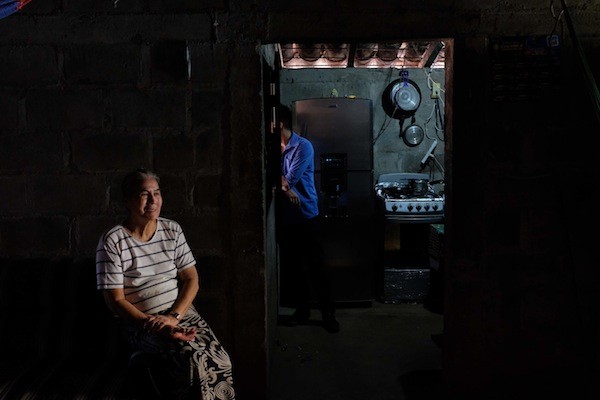
- Pedro in his current home with his grandmother.
Pedro wasn't allowed to call his mother or anyone in El Salvador before he left, and no one from ICE or Stewart notified the family of his deportation. But Carmen had missed a scheduled call from him that day and instinctively sent for her sister and parents to make the four-hour drive to San Salvador to pick him up.
From her kitchen table in Charlotte, she arranged for everything. His family was there within 45 minutes of his arrival. They met him at the cafe outside of the exit door.
The Salmerons and thousands of similarly situated families — mixed immigration status, separated — are caught in the limbo of a legal system that often feels arbitrary and feeds on income inequality.
"This is a system set up by and administered by human beings," says Maureen Abel, a staff attorney at the Immigrant Justice Project, a program of the Charlotte Center for Legal Advocacy. "This means all of our human failings are going to seep into it. It's inevitable. Unless we have institutional safeguards against it, it's going to happen."
According to the American Immigration Council, just 37 percent of immigrants facing removal and 14 percent of immigrants in detention secure representation. And though undocumented immigrants are being imprisoned, immigration is a civil matter, not a criminal one, meaning detainees have no Sixth Amendment right to an attorney.
Even if they did, it's often cost-prohibitive for immigrants who work low-paying jobs without legal status. Daniel Salmeron works six days a week as a construction worker; Carmen works the same amount of time for far less money as a domestic worker. She says they spent $2,800 on the first lawyer and about $5,000 on Brad Banias.
But the costs and the physical risks won't deter Central American immigrants from trying to cross the border, Abel says.
"People get [to this stage] fleeing for their lives because they are confused or don't have the money to go through the process, or because they are afraid that they will lose," Abel says. "They legitimately believe they will die going home, so they prioritize being alive over going through legal status."
"These are brave people," Quintanilla says, "and there's nothing [in El Salvador] pushing them to stay."
Even a year after Pedro's deportation, Banias remains tenacious on his behalf. Earlier this month, he filed a last-ditch appeal arguing that, because Pedro's unaccompanied-minor status wasn't explicitly revoked on paper by another agency — as legally required — upon his detainment as an adult, U.S. Citizenship and Immigration Services "is instructed to assume he's still an unaccompanied minor and not look beyond the issue." That, he says, "would have gotten him that asylum hearing that was scheduled."
If Banias's argument prevails, Pedro's case would set a precedent. And if Pedro is granted an asylum hearing, Banias says, that would legally require him to return to the U.S., where he could "live a normal life" while the asylum process plays out, perhaps over two or three years.
"If the best I can do is create chaos and get them to answer these questions, I'm going to do that," says Banias. "I think in front of the right judge, it's a strong argument. We've been fighting for Pedro for so long—this is it, there's no other avenue. Any time you have an argument that hasn't been heard in any other part of the country, you've got a shot."
Every Sunday for the nine months Pedro was at Stewart, the Salmerons traveled seven hours roundtrip to see him for an hour. Throughout those visits, Carmen watched 40 pounds dwindle from her son's already-thin frame. That "malnourished" image is etched in her memory.
Her one consolation these days is seeing Pedro through video chats, his face plumper, well-fed by her own mother. He calls her on the rare occasions when he leaves this house: "I'm going shopping, Mama. Want to tag along?"
"It's the only way we can still feel close," Carmen says. "It's like I'm walking through the streets with him. I get to see the mountains."
The family will face a tough choice in the coming months, and they're not sure what to do. As with most migrants, their lives have been transient and unpredictable. But now there's a deadline: they have less than 18 months before Daniel's TPS visa expires.
"The truth is, here we have a lot. But in El Salvador, we have Pedro," Carmen says, smiling through tears. "We can't take away our daughter's future. We would do anything for her."
Some 3,000 miles away from his family's home in Charlotte, Pedro says his only choice is to remain hopeful, to look at what's in front of him and not get wrapped up in long-term goals.
"Life without papers in the United States isn't easy, but my life was relatively good," he says. "Here, I'm missing so many things. It's like I'm back in my infancy."
His immediate plan is to finally graduate from high school. His dream is to play music for a living, but he says that lifestyle won't earn him much respect in El Salvador. He likes drawing and computers; if he can afford it, maybe he'll go to school for graphic design.
Collectively, the family has survived a brutal civil war and crushing poverty in El Salvador and imprisonment in the U.S. In both of their homes, they've lived with uncertainty, fearful that anything they've earned can be taken away.
The day I visited in September, Pedro's grandmother set a pot of beans on the kitchen table, waiting for Pedro to come back from an appointment, part of his effort to obtain a work permit. The family's dairy profits have diminished since gangs took over the area, but fresh cheese and homemade tortillas serve as beautiful remnants of what is still possible in a country with deep scars.
She walked out to the back porch to water a pot of herbs, her silhouette framed by green hills and bright blue sky. Unprompted, she told me that Pedro is "fighting to simply get ahead."
"Freedom is what he doesn't have," she added. "He just has bad luck."
Reporting for this story was supported by the International Women's Media Foundation.



